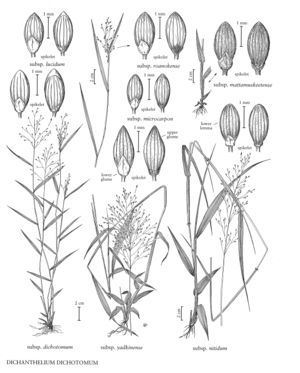Difference between revisions of "Dichanthelium dichotomum subsp. microcarpon"
FNA>Volume Importer |
imported>Volume Importer |
||
| (8 intermediate revisions by 2 users not shown) | |||
| Line 1: | Line 1: | ||
{{Treatment/ID | {{Treatment/ID | ||
|accepted_name=Dichanthelium dichotomum subsp. microcarpon | |accepted_name=Dichanthelium dichotomum subsp. microcarpon | ||
| − | |accepted_authority= | + | |accepted_authority= |
|publications= | |publications= | ||
|basionyms= | |basionyms= | ||
|synonyms={{Treatment/ID/Synonym | |synonyms={{Treatment/ID/Synonym | ||
|name=Panicum dichotomum var. ramulosum | |name=Panicum dichotomum var. ramulosum | ||
| − | |authority= | + | |authority= |
| − | }}{{Treatment/ID/Synonym | + | |rank=variety |
| + | }} {{Treatment/ID/Synonym | ||
|name=Panicum microcarpon | |name=Panicum microcarpon | ||
|authority=Muhl. ex Elliott | |authority=Muhl. ex Elliott | ||
| + | |rank=species | ||
}} | }} | ||
|hierarchy=Poaceae;Poaceae subfam. Panicoideae;Poaceae tribe Paniceae;Dichanthelium;Dichanthelium sect. Dichanthelium;Dichanthelium dichotomum;Dichanthelium dichotomum subsp. microcarpon | |hierarchy=Poaceae;Poaceae subfam. Panicoideae;Poaceae tribe Paniceae;Dichanthelium;Dichanthelium sect. Dichanthelium;Dichanthelium dichotomum;Dichanthelium dichotomum subsp. microcarpon | ||
| Line 21: | Line 23: | ||
-->{{Treatment/Body | -->{{Treatment/Body | ||
| − | |discussion=<p>Dichanthelium dichotomum subsp. microcarpon grows in wet woods, swamps, and wetland borders. It is a widespread subspecies, extending from southern Michigan to Massachusetts and south to eastern Oklahoma and Texas and throughout the southeast to central Florida.</p> | + | |discussion=<p><i>Dichanthelium dichotomum </i>subsp.<i> microcarpon</i> grows in wet woods, swamps, and wetland borders. It is a widespread subspecies, extending from southern Michigan to Massachusetts and south to eastern Oklahoma and Texas and throughout the southeast to central Florida.</p> |
|tables= | |tables= | ||
|references= | |references= | ||
| Line 30: | Line 32: | ||
-->{{#Taxon: | -->{{#Taxon: | ||
name=Dichanthelium dichotomum subsp. microcarpon | name=Dichanthelium dichotomum subsp. microcarpon | ||
| − | + | |authority= | |
| − | |authority= | ||
|rank=subspecies | |rank=subspecies | ||
|parent rank=species | |parent rank=species | ||
| Line 37: | Line 38: | ||
|basionyms= | |basionyms= | ||
|family=Poaceae | |family=Poaceae | ||
| + | |illustrator=Linda A. Vorobik;Hana Pazdírková | ||
| + | |illustration copyright=Utah State University | ||
|reference=None | |reference=None | ||
|publication title= | |publication title= | ||
|publication year= | |publication year= | ||
|special status= | |special status= | ||
| − | |source xml=https:// | + | |source xml=https://bitbucket.org/aafc-mbb/fna-data-curation/src/200273ad09963decb8fc72550212de541d86569d/coarse_grained_fna_xml/V25/V25_1179.xml |
|subfamily=Poaceae subfam. Panicoideae | |subfamily=Poaceae subfam. Panicoideae | ||
|tribe=Poaceae tribe Paniceae | |tribe=Poaceae tribe Paniceae | ||
Latest revision as of 17:55, 11 May 2021
Culms 30-100 cm, slender, erect or geniculate; fall phase freely branching from all nodes, reclining from masses of branchlets and numerous reduced, ciliate blades and secondary panicles; nodes conspicuously bearded with retrorse hairs. Sheaths usually glabrous, lowermost sheaths sometimes sparsely pubescent, occasionally with whitish spots between the veins, ciliate along the margins; blades 5-14 cm long, 5-14 mm wide, thin, spreading to reflexed, glabrous on both surfaces, bases with few to many papillose-based cilia. Panicles 5-12 cm, well-exserted, dense. Spikelets 1.5-1.8 mm, usually glabrous, rarely slightly pubescent. Lower glumes usually less than 14 as long as the spikelets; upper glumes usually shorter than the lower lemmas; upper florets 1.3-1.6 mm long, 0.6-0.8 mm wide, subacute. 2n = 18.
Discussion
Dichanthelium dichotomum subsp. microcarpon grows in wet woods, swamps, and wetland borders. It is a widespread subspecies, extending from southern Michigan to Massachusetts and south to eastern Oklahoma and Texas and throughout the southeast to central Florida.
Selected References
None.
